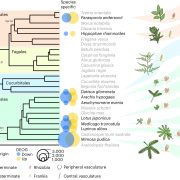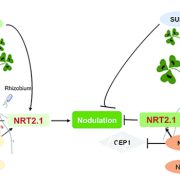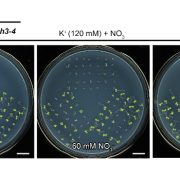How do legumes decide where to get nitrogen––from the soil or from nitrogen-fixing bacteria?
Misawa, Ito, et al. explore how nitrate transporters and NIN-like protein transcription factors repress nodulation in the presence of exogenous nitrate.
Momoyo Ito, Takuya Suzaki
Faculty of Life and Environmental Sciences, University of Tsukuba, Tsukuba, Ibaraki, Japan
Background
Through symbiosis with nitrogen-fixing bacteria, legumes can use nitrogen from the atmosphere as a nutrient. However, root nodule symbiosis requires energy and plants save energy when they can. For example, plants temporarily halt root nodule symbiosis when the soil contains an abundance of nitrogen-containing nutrients such as nitrate. In other words, plants have a mechanism to control root nodule symbiosis upon changes in the amount of nitrate. Using the model legume Lotus japonicus, we previously identified the NIN-LIKE PROTEINs LjNLP1 and LjNLP4 as key transcription factors that play pivotal roles in this regulation. However, how nitrate acts in the signaling pathway to control nodulation remains largely unknown.
Question
How do legume nitrate transporters control root nodule symbiosis in a nitrate-rich environment?
 Findings
Findings
By analyzing mutants involved in the nitrate-mediated control of root nodule symbiosis, we showed that a defect in the nitrate transporter gene LjNRT2.1 results in the maintenance of nodulation in nitrate-rich environments. We also found that LjNLP1 directly regulated LjNRT2.1 expression. Furthermore, our data suggest that LjNRT2.1-mediated nitrate influx into the cell is relevant to nuclear localization of LjNLP4 and subsequent regulation of the expression of nodulation-related genes. Interestingly, LjNIN, a nodulation-specific transcription factor, controls nitrate uptake by interfering with LjNRT2.1 expression by LjNLP1. These findings enhance our understanding of the mechanisms of nitrogen acquisition that is unique to nodulating plants.
Next steps
In plant evolution, legumes that depend on nodules for their nitrogen source may have developed a unique mode of nitrogen acquisition. Comparative functional analysis of nitrate transporter genes, including NRT2.1, in various plants may be useful in testing this hypothesis.
Reference:
Fumika Misawa, Momoyo Ito, Shohei Nosaki, Hanna Nishida, Masahiro Watanabe, Takamasa Suzuki, Kenji Miura, Masayoshi Kawaguchi, and Takuya Suzaki (2022) Nitrate transport via NRT2.1 mediates NIN-LIKE PROTEIN-dependent suppression of root nodulation in Lotus japonicus. https://doi.org/10.1093/plcell/koac046







